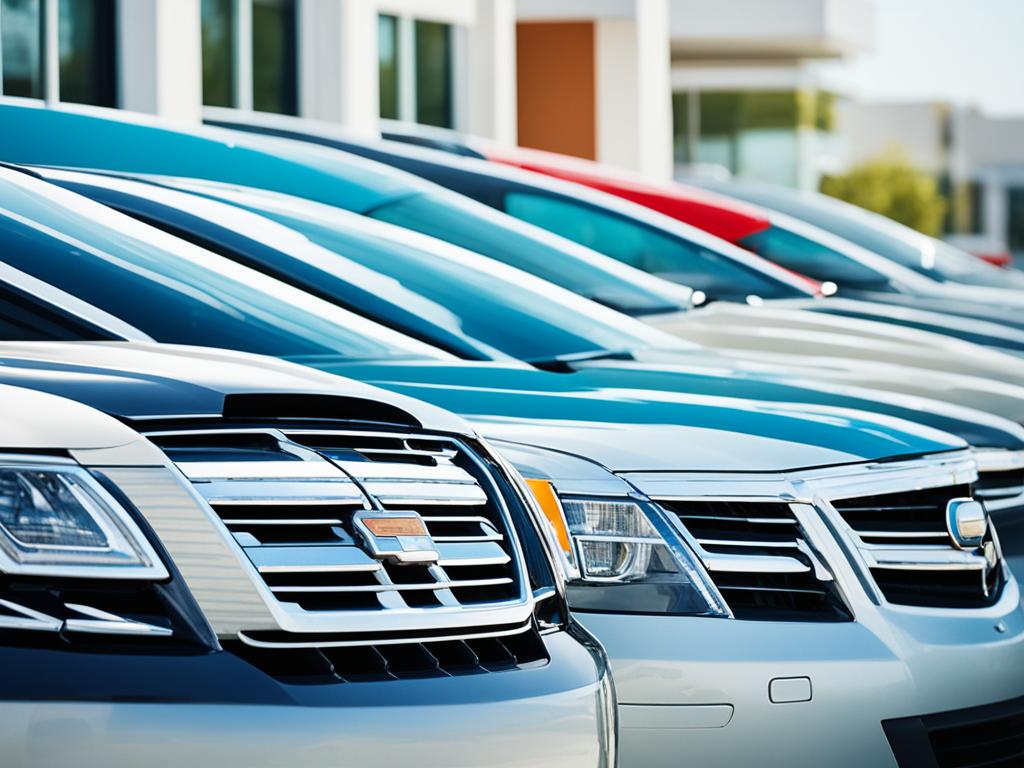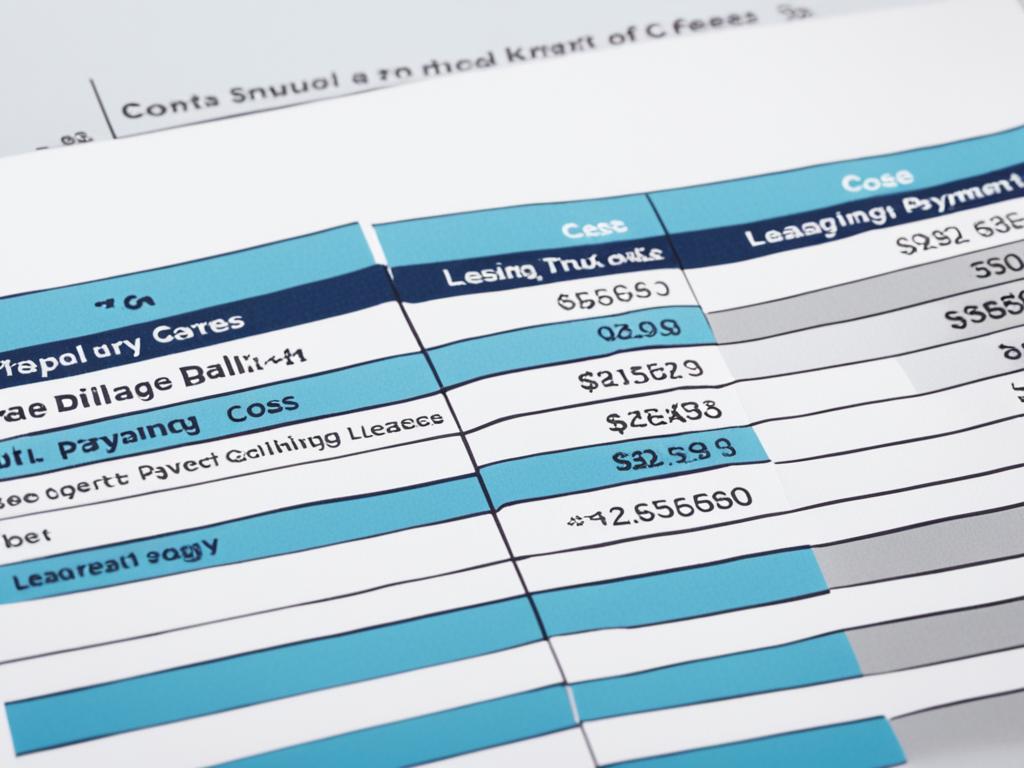
Pros and Cons of Leasing vs Buying a Car
Choosing between leasing vs buying a car is a big decision for car buyers. This article will help you understand the main points to think about. It will guide you in making a choice that fits your budget, driving needs, and financial goals.

Leasing and buying cars have their own pros and cons. Knowing the differences between leasing vs buying a car can help you pick the best option for you. Whether you want a new vehicle purchase or are looking at auto lease options, this article will give you the information you need.
We’ll look at monthly payments and ownership costs. We’ll also talk about how residual value and mileage limits affect your choices. By the end, you’ll know what to consider when deciding between leasing a car or buying a car.
Understanding the Basics of Car Leasing
Before deciding to auto lease or buy a car, it’s key to understand car leasing. This part will cover what a car lease is and how the leasing process works. We’ll look at monthly payments, mileage limits, and what to do at lease end.
What is a Car Lease?
A car lease lets you pay a monthly fee to use a car for a set time, usually 24 to 36 months. The car’s owner, often a dealership or finance company, gets this payment. At lease end, you can return the car or buy it.
How Does Leasing Work?
The leasing process has a few main steps:
- Negotiate the car lease terms, like monthly payments, down payment, and mileage limit.
- Sign the lease, which details your duties and lease terms.
- Pay the down payment and monthly payments during the lease.
- Keep the car in good shape as per the manufacturer’s advice and lease agreement.
- At lease end, you can return the car or buy it.
Knowing the basics of car leasing helps decide if it fits your needs and budget.

Advantages of Leasing a Car
Leasing a car has many benefits. One big plus is the chance for lower monthly payments than buying a car. You get to drive a new model without the big upfront cost or the long-term ownership hassle.
Leasing lets you always drive a new vehicle. With leases lasting 2-4 years, you can switch to the newest models with the latest tech every few years. This means you’re always driving the latest in car technology.
Leasing also means you’re not stuck with one car for years. When your lease ends, you can return the car, buy it, or lease a new one that fits your changing needs better.

The benefits of leasing a car include lower monthly payments and the chance to drive a new car every few years. It’s a great choice for those who want the newest features and don’t want the long-term commitment of owning a car.
Disadvantages of Leasing a Car
Leasing a car has its pros and cons. Two main downsides are mileage limits and not owning the car at lease end.
Mileage Limits
One big drawback of leasing a car is mileage limits. Leases usually have an annual mileage cap, like 12,000 to 15,000 miles a year. Going over this limit means extra fees for each mile. This can get expensive, especially for those with long commutes or who travel a lot.
No Ownership at the End
Another big disadvantage of leasing a car is you don’t own the vehicle. When the lease ends, you must return the car or buy it at a set price. This means you can’t build equity in the car, unlike buying one. For some, not owning the car they drive is a big turn-off.
When thinking about leasing, consider the mileage limits and lack of ownership against the benefits. These include lower monthly payments and getting to drive a new car often. Knowing both sides helps you make a choice that fits your driving and financial needs.

Leasing vs Buying a Car
Choosing between leasing and buying a car affects your finances. Each option has its pros and cons. It’s important to think about your priorities and goals before deciding.
Monthly payments are a big factor. Leasing usually means lower monthly costs because you’re paying for the car’s depreciation. Buying a car means your monthly payments go down as you pay off the loan.
Ownership is another key point. With leasing, you don’t own the car. But with buying, you have full control over it. This is crucial if you plan to keep the car long or modify it.
Long-term costs differ between leasing and buying. Leasing can be cheaper if you don’t drive much or want a new car often. But buying can save money if you keep the car for many years, avoiding mileage and wear-and-tear fees.

The choice between leasing and buying depends on your driving, finances, and goals. Think about the benefits and drawbacks of each option to make the best choice for you.
Leasing vs Buying a Car: Factors to Consider When Choosing
When deciding between leasing and buying a car, think about your driving habits, money situation, and future goals. These factors will help you pick the best choice for you.
Driving Habits
Look at how much you drive. If you drive little, leasing might be good since it has mileage limits. But, if you drive a lot, buying could be better to avoid mileage fees.
Leasing vs Buying a Car: Financial Situation
Check your financial situation and what you hope for in the future. Leasing usually means lower monthly payments, great for those watching their budget. But, if you want to keep the car long-term, buying might save you money since you own it fully.
Leasing vs Buying a Car: Long-Term Goals
Think about your long-term goals and if you want to own the car or just enjoy driving new ones. Leasing lets you try out new cars but you won’t own them. Buying means you can build equity and maybe sell the car later.

By thinking about these things, you can make a choice that fits your driving needs, financial situation, and long-term goals. This way, you pick the best option for you.
Conclusion
Choosing between leasing and buying a car depends on what you want, your money situation, and your future plans. Leasing lets you pay less each month and try out new cars often. But, you have to watch your mileage and don’t own the car at the end. Buying a car means you own it and might save money over time. But, you pay more upfront and your monthly payments could be higher.
When deciding, think about your driving habits, money situation, and what you need for the future. This way, you can pick the best choice for you. It’s about finding a balance that meets your goals and makes financing your car easy.
Whether you lease or buy, do your homework, negotiate well, and choose what fits your needs now and later. Being informed and thoughtful helps you pick the right car financing option. This way, you can confidently find the best solution for you.
FAQ
What is a car lease?
A car lease lets you “rent” a vehicle for a set time, usually 24-36 months. You pay monthly during the lease. At the end, you can return it, buy it, or lease a new one.
How does the leasing process work?
Leasing a car means agreeing to a lease term, mileage limit, and monthly payment. At lease end, you can return it, buy it, or lease again. The leasing company owns the car, and you pay to use it.
What are the advantages of leasing a car?
Leasing has lower monthly payments, lets you drive a new car, and allows easy upgrades. You can switch cars at lease end.
What are the disadvantages of leasing a car?
Leasing has mileage limits, no car customizing, and no ownership at lease end. You might pay for extra wear and tear or mileage over the limit.
How do leasing and buying a car compare?
Leasing offers lower payments but no car ownership. Buying has higher costs but you own the car. The best choice depends on your driving, finances, and goals.
What factors should I consider when choosing between leasing vs buying a car?
Think about your driving habits, finances, and goals. Consider your mileage, budget, credit score, and what you want long-term. This will help you pick the best option for you.



What are some common mistakes or misconceptions people make when choosing between leasing and buying a car?
Car leasing is good in some circumstances and bad also, one has to be careful when leasing a car.